As PC partner Brand (alongside Inno3D and Manli), Zotac proudly celebrated its 10th anniversary last winter. The fact that the business has been so good so far is not only due to the mass-produced products in the entry-level segment and the middle class, but also to the cards for enthusiasts, who are now using the Zotac GTX 1080 Ti Amp! Extreme Edition puts a new flagship in the ancestral gallery.
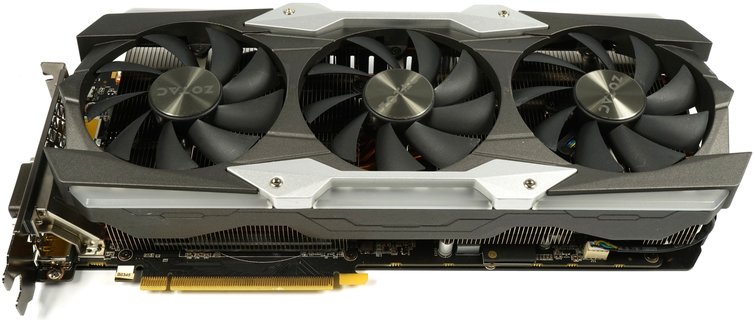
Since the specifications of the standard or Reference models ("Nvidia GeForce GTX 1080 Ti 11GB in test") do not let gaming target group-like scene, then it has to be a little more and so Zotac reaches deep into the material box and sends the latest offspring right to the strong guys in Super heavyweight. Why just clap when you can put one on it? There are enough sparring partners, but how well does the advertised steam hammer really work? We have promised many detailed answers to the most important questions.
Since the actual performance of all board partner cards depends more on the actual boost clock achieved, and thus causally depends on the cooling, the power target and above all the quality of the respective chip, any test based only on benchmark bars is more of a Random snapshot of a single specimen. This is precisely why we have focused on the actual technical implementation of each model and have been able to document this very well with our equipment.
Unboxing, dimensions and connections
The map is what is called a "thick knocker" that can hardly run even visually before power. In order to put the muckis even better in the scene, it is not quite uncommon in certain pumper circles to wear far too scarce clothes, in which one comes more like Hassan, the adrenaline-filled 2-slot liver sausage. Not so the Amp! Extreme Edition, which proudly shows belly and instead prefers to claim the whole converted space just for itself.
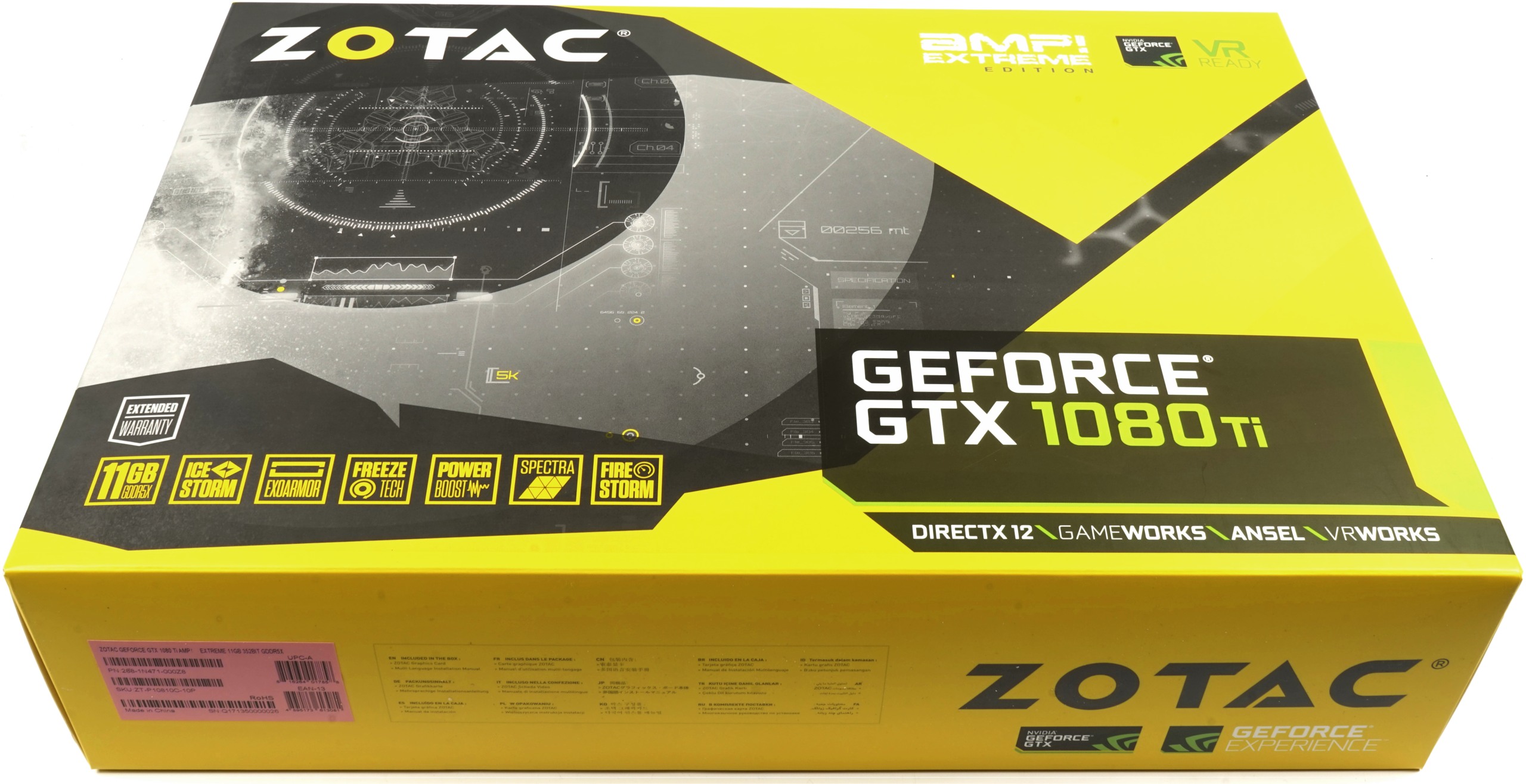
With an extreme weight of 1,568 kilos, an above-average 31 cm real installation length (outer edge slot aperture to the end of the cover), a height of 13 cm (upper edge motherboard slot to top edge cover) and a mounting depth of a massive 5.3 cm, the 2.5-slot card is namely a real thickener, which on the back then also approx. 0.5 cm of space is required, which should be taken into account in large tower coolers.
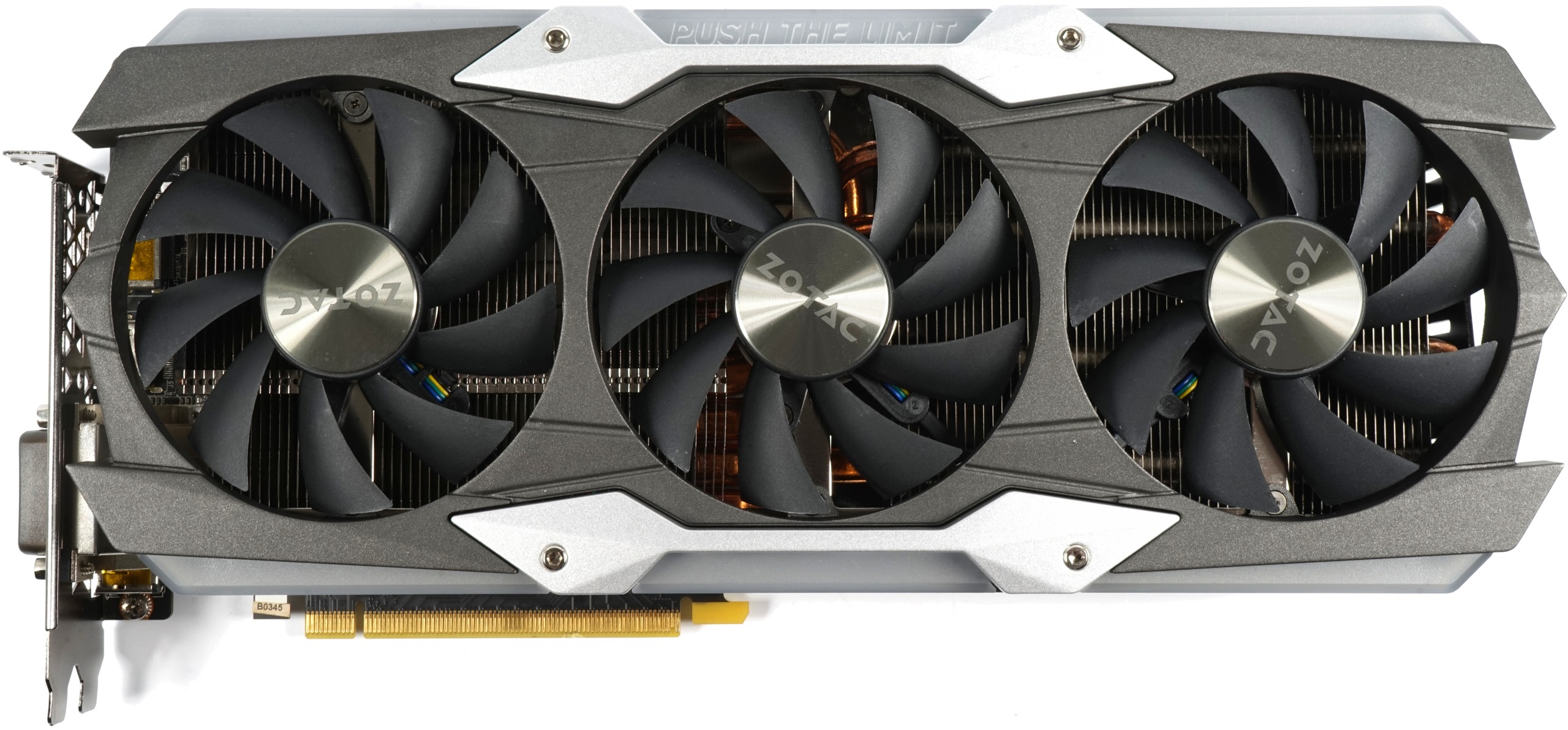 |
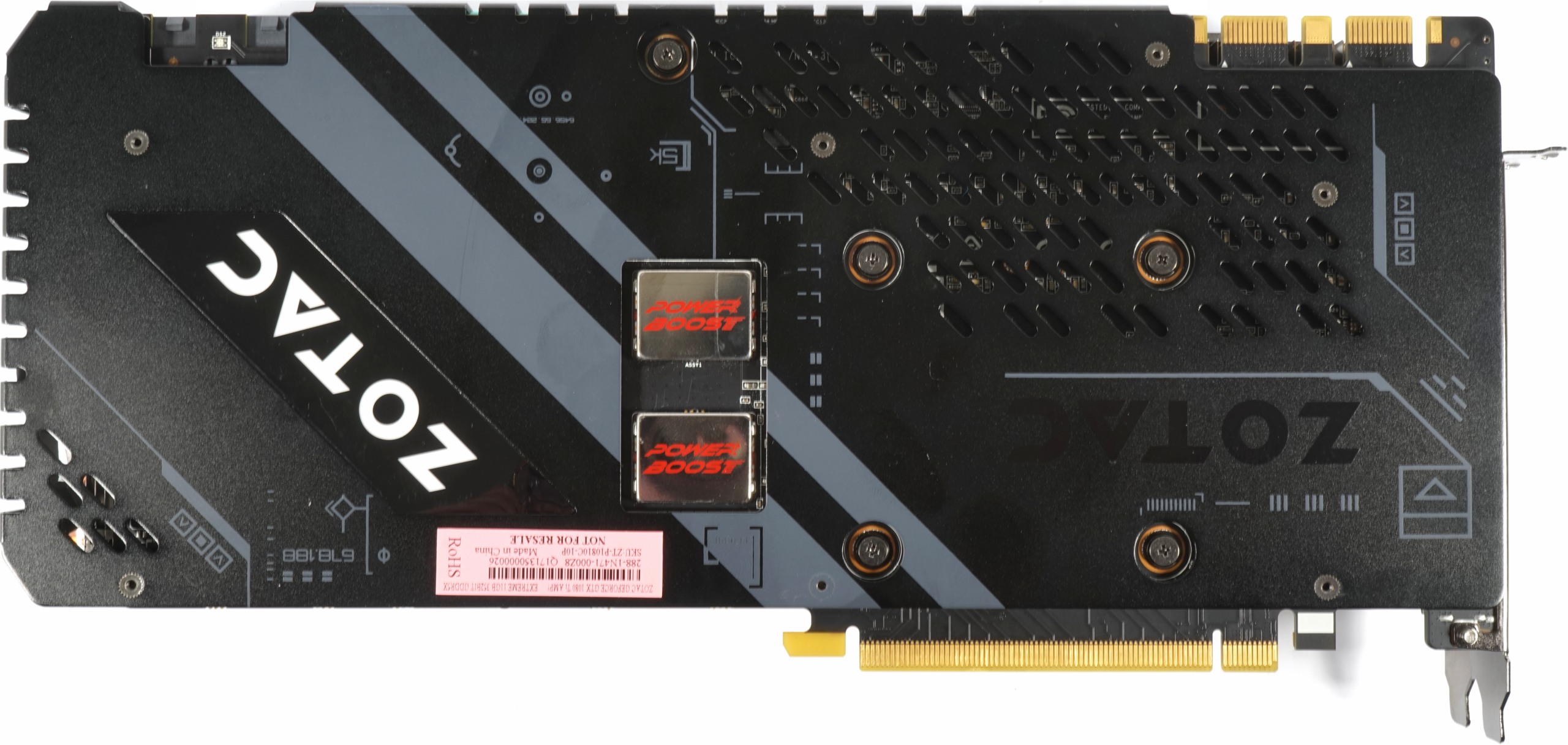 |
The material mix of predominantly plastic for the cover still feels reasonably valuable. The design line is consistently followed up and you won't find any real optical surprises besides some contemporary modifications. The backplate is also partially a cover for areas of the top and bottom, but only stabilizes and should above all look beautiful. It cannot (yet) cool down and the pad industry has not yet been able to gain a new major customer with Zotac. But that's still going to happen, bet? At Sapphire, just one floor away, you will certainly find enough pads to borrow.
The top is embossed with the RGB backlit Zotac logo, as well as a white-only "Geforce GTX" lettering. The two 8-pin power supply connections sit 180° rotated at the end of the board of the top.

The bottom and top show the vertical slat orientation of the cooler and the absence of a real VRM heat sink that could actively cool other assemblies. Instead, there sits on the board a piece of stranded aluminium puffed on from above, whose smaller brother will be able to get on the right. Is the splitting of the coolers still taking revenge? We will also be testing for this, because some healthy scepticism is already spreading.

The end of the card shows two 8 mm and three 6 mm heatpipes for the right part of the radiator structure. However, from this side the sixth, another 6 mm heatpipe, is not visible from the outside. But more on that later. Zotac's connectivity is more based on standard costs from an HDMI 2.0 port, as well as three DisplayPort 1.4 jacks and a revived dual-link DVI-D connector (pictured right). Nvidia had already saved it as a precautionary measure when it came to reference design.
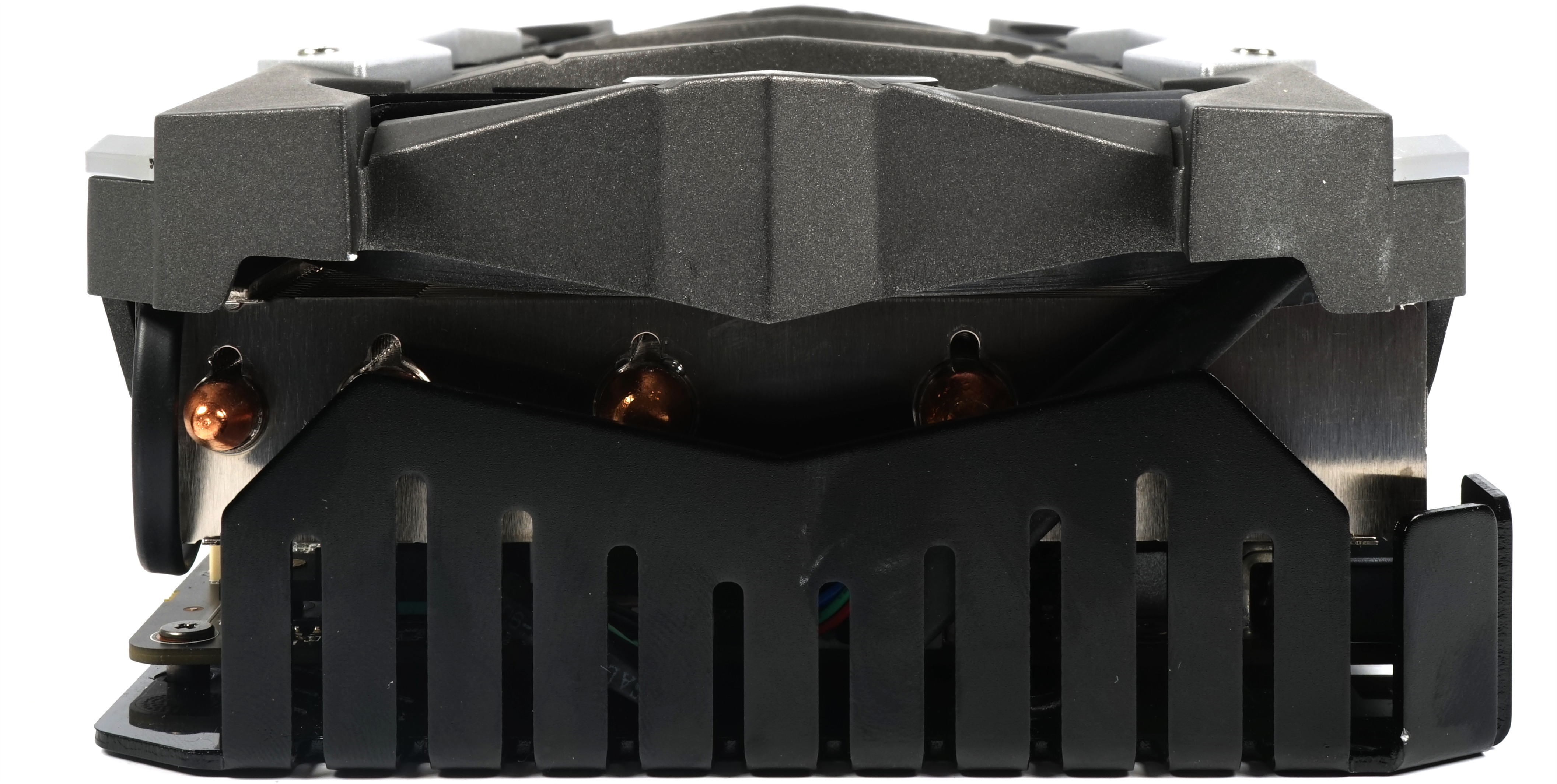 |
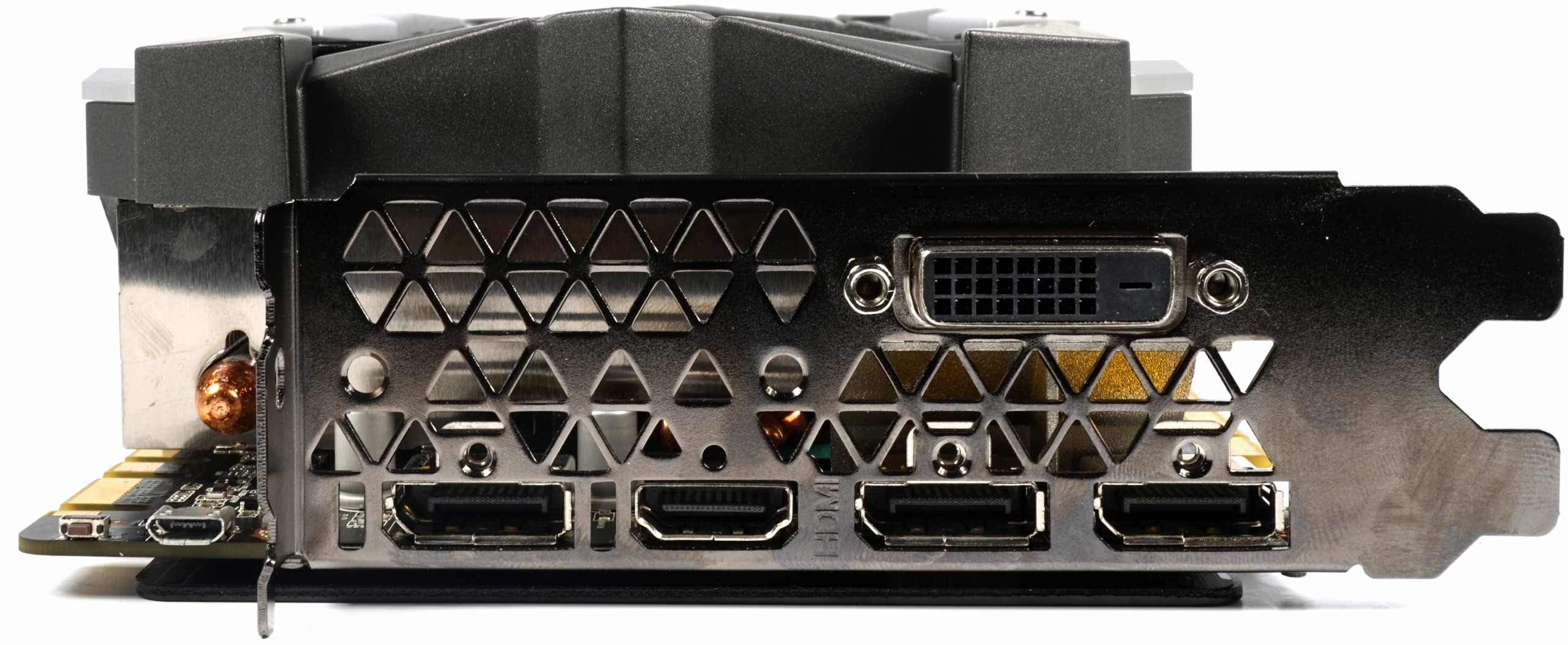 |
Specifications
The GPU-Z screenshot shows us the most important key data in advance, whereby the actual boost achieved with our model was significantly higher:
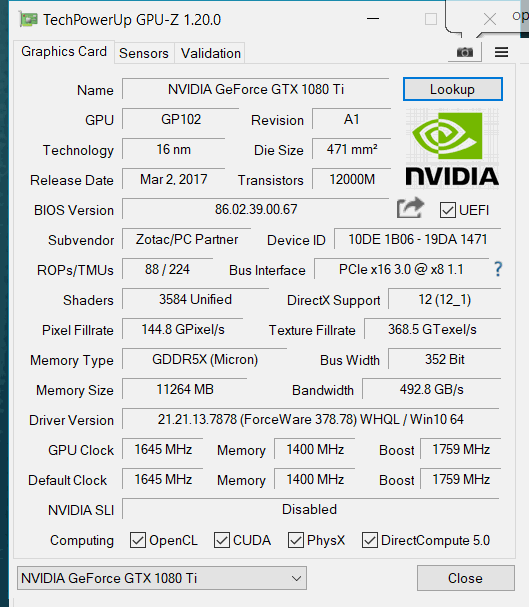
Finally, the whole thing again as a tabular comparison to the other relevant graphics card models:
| Nvidia Titan X – (Pascal) Mr President, I would like to |
Nvidia Geforce GTX 1080 Ti FE |
Zotac GTX 1080 Ti Amp! Extreme Edition |
Nvidia Geforce GTX 1080 FE |
Nvidia Geforce GTX 980 Ti |
|
|---|---|---|---|---|---|
| Gpu |
GP102 | GP102 | GP102 | GP104 | GM200 |
| CUDA cores |
3584 | 3584 | 3584 | 2560 | 2816 |
| Base clock | 1417 MHz | 1480 MHz | 1645 MHz |
1607 MHz | 1000 MHz |
| Boost clock |
1531 MHz+ | 1582 MHz+ | 1759 MHz |
1733 MHz+ | 1076 MHz+ |
| Memory Size & Type |
12 GByte GDDR5X |
11 GByte GDDR5X |
11 GByte GDDR5X |
8 GByte GDDR5X |
6 GByte GDDR5 |
| The size |
471 mm2 | 471 mm2 | 471 mm2 | 314 mm2 | 601 mm2 |
| Technology |
16 nm | 16 nm | 16 nm | 16 nm | 28 nm |
| Transistors |
12 billion | 12 billion | 12 billion | 7.2 billion | 8 billion |
| Streaming Multiprocessors (SM) |
28 | 28 | 28 |
20 | 22 |
| GFLOPS (basic clock) |
10.157 | 10.609 | 11.068 |
8.228 | 5.632 |
| Texture Units |
224 | 224 | 224 | 160 | 176 |
| Texture fill rate |
317.4 GT/s | 331.5 GT/s | 368.5 GT/s |
257.1 GT/s | 214 GT/s |
| Rops |
96 | 88 | 88 |
64 | 96 |
| Pixel fill rate |
136 GPix/s | 130.24 GPix/s | 144.8 GPix/s |
114.2 GPix/s | 116.7 GPix/s |
| Storage data rate |
10 Gbps | 11 Gbps | 11 Gbps | 10 Gbps | 7 Gbps |
| Storage bus |
384 bits | 352 bits | 352 bits | 256 bits | 384 bits |
| Memory bandwidth |
480 GByte/s | 484 GByte/s | 492.8 GByte/s | 320 GByte/s | 336 GByte/s |
| L2 cache |
3 MByte | 2816 KByte | 2816 KByte | 2 MByte | 3 MByte |
| Tdp |
250 watts | 250 watts | 300 Watt (PT) |
180 watts | 250 watts |
Test system and measurement methods
The new test system and the methodology have already been described in great detail in the basic article "How We Test Graphics Cards" (English: "How We Test Graphics Cards") and therefore, for the sake of simplicity, we now only refer to this detailed Description. So if you want to read everything again, you are welcome to do so. However, we have improved CPU and cooling once again in order to largely exclude possible CPU bottle necks for this fast card.
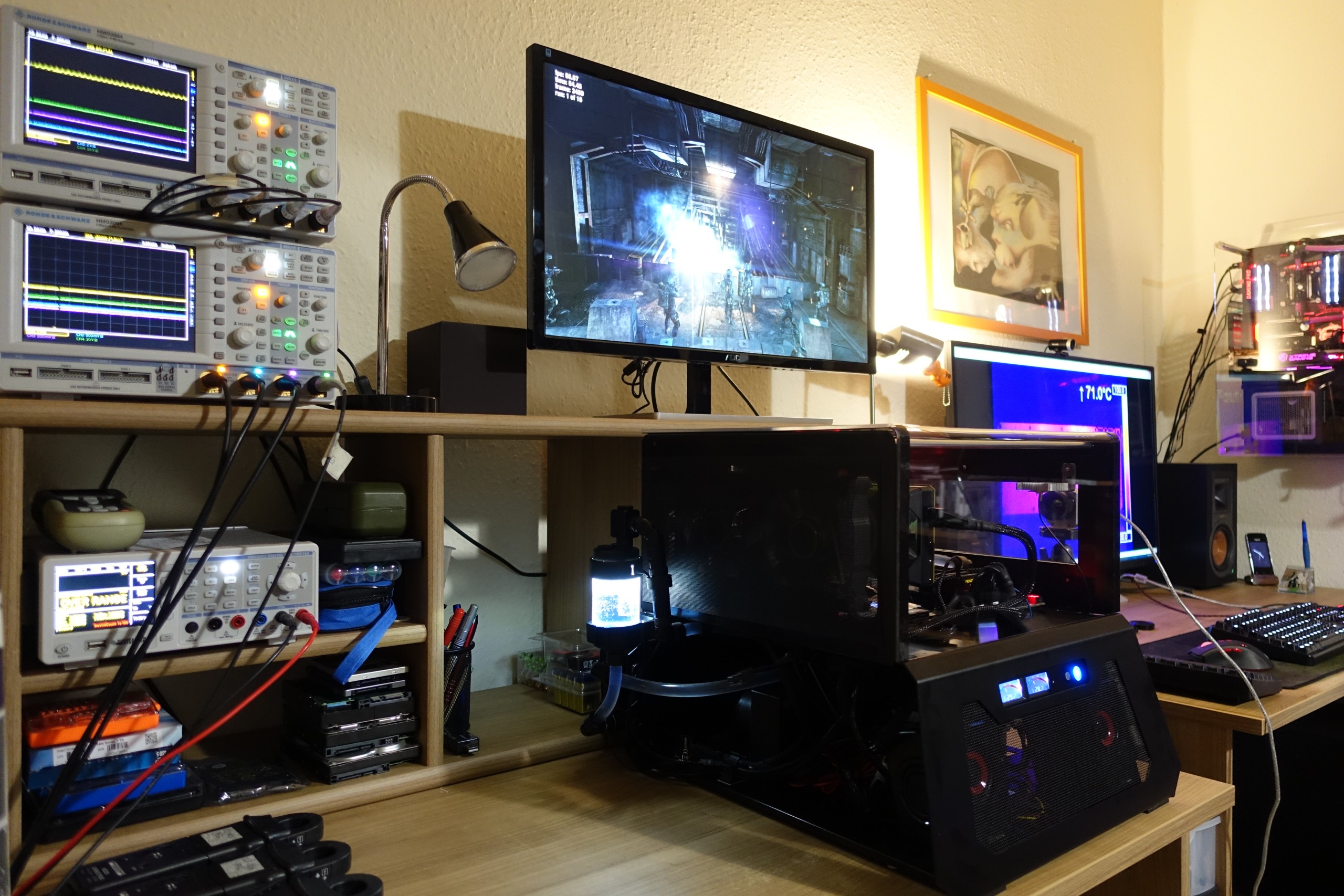
If you are interested, the summary in table form quickly provides a brief overview:
| Test systems and measuring rooms | |
|---|---|
| Hardware: |
Intel Core i7-6900K -4.3GHz MSI X99S XPower Gaming Titanium Corsair Vengeance DDR4-3200 1x 1 TByte Toshiba OCZ RD400 (M.2, System SSD) 2x 960 GByte Toshiba OCZ TR150 (Storage, Images) Be Quiet Dark Power Pro 11, 850-watt power supply Windows 10 Pro (all updates) |
| Cooling: |
Alphacool Ice Block XPX Alphacool Ice Age 2000 Chiller 2x Be Quiet! Silent Wings 3 PWM (Closed Case Simulation) Thermal Grizzly Kryonaut (for cooler change) |
| Housing: |
Lian Li PC-T70 with expansion kit and modifications Modes: Open Benchtable, Closed Case |
| Power consumption: |
non-contact DC measurement on the PCIe slot (Riser-Card) non-contact DC measurement on the external PCIe power supply Direct voltage measurement on the respective feeders and on the power supply 2x Rohde & Schwarz HMO 3054, 500 MHz multi-channel oscillograph with memory function 4x Rohde & Schwarz HZO50, current togor adapter (1 mA to 30 A, 100 KHz, DC) 4x Rohde & Schwarz HZ355, touch divider (10:1, 500 MHz) 1x Rohde & Schwarz HMC 8012, digital multimeter with storage function |
| Thermography: |
Optris PI640, infrared camera PI Connect evaluation software with profiles |
| Acoustics: |
NTI Audio M2211 (with calibration file) Steinberg UR12 (with phantom power for the microphones) Creative X7, Smaart v.7 own low-reflection measuring room, 3.5 x 1.8 x 2.2 m (LxTxH) Axial measurements, perpendicular to the center of the sound source(s), measuring distance 50 cm Noise in dBA (Slow) as RTA measurement Frequency spectrum as a graph |

































Kommentieren